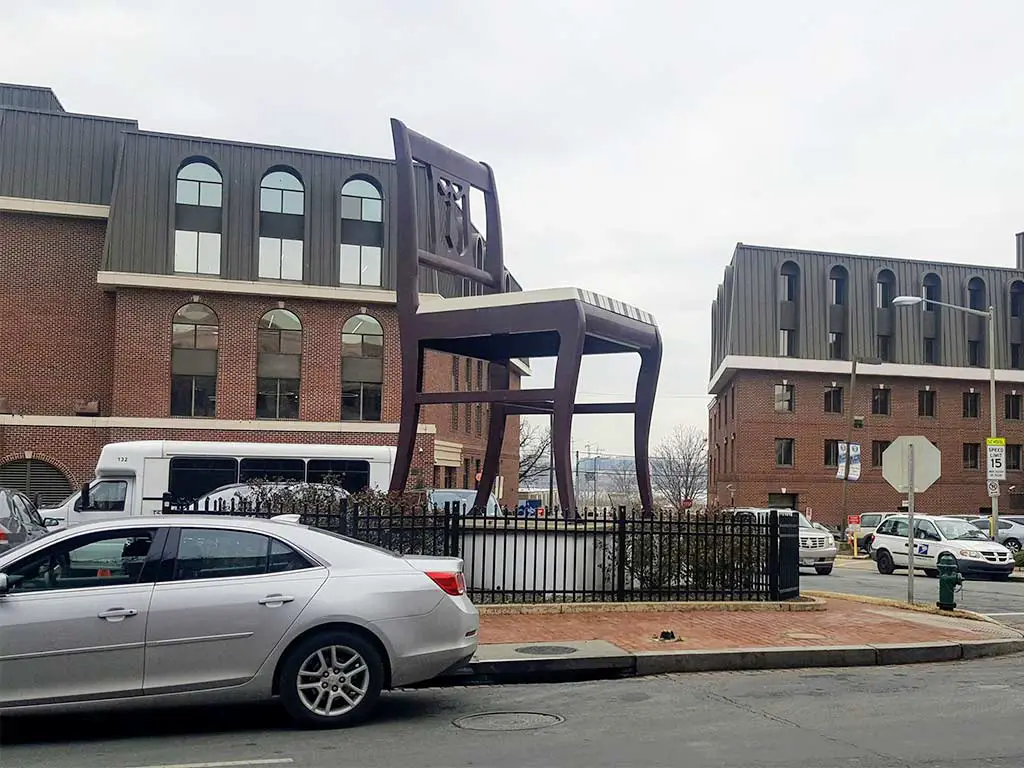Have you ever wondered about the iconic big chair in Washington, DC? This historic landmark holds a story that spans over three decades, with its fate now resting in the hands of a dedicated contractor named John Kidwell.
Kidwell’s commitment to restoring the chair, despite its daunting state of disrepair, reflects a labor of love and a testament to preserving a piece of local history.
As you delve into the intricate details of this restoration project, you’ll uncover the challenges faced by Kidwell, who likened the process to a medical battle against a formidable foe.
With estimates suggesting a two-month timeline and a $30,000 cost for repairs, the magnitude of this endeavor becomes apparent.
The chair’s transformation from a weathered relic to a revitalized symbol of resilience embodies the essence of historical preservation in the heart of the nation’s capital.
Origins of the Big Chair

The Big Chair, an iconic landmark in Washington, D.C., has its origins deeply rooted in the city’s industrial history.
Here’s a glimpse into its origins:
The Initial Concept and Construction
The Big Chair in Washington, DC, had its origins in a mahogany structure that stood as a symbol in Anacostia for many years.
The chair faced challenges as it deteriorated over time, with numerous holes patched with concrete to maintain its integrity. In August 2005, the original chair had to be removed due to its deteriorating condition.
However, eight months later, a new chapter began as a $40,000 aluminum replica was erected in the chair’s original location. This significant event marked a symbol of hope and resilience in the community.
Symbolism and Design
The Big Chair is not just a piece of furniture; it encompasses a deep-rooted symbolism in Washington, DC. Serving as an oversized emblem of Anacostia, the chair holds historical significance and cultural value in the area.
Its design and grandeur make it a landmark that residents and visitors alike recognize as a symbol of strength and endurance.
The chair’s enduring presence reflects the spirit of the community and its ability to adapt and thrive despite challenges.
From being a deteriorating relic to a renewed beacon of hope, the Big Chair’s symbolism and design continue to inspire generations.
The Big Chair as a Cultural Icon

The Big Chair in Washington, D.C., has transcended its origins as a simple industrial landmark to become a cherished cultural icon with deep significance for the community.
Here’s a look at how the Big Chair has evolved into a symbol of pride, resilience, and community identity:
Role in Anacostia’s Community
The Big Chair in Washington, DC, serves as more than just a piece of furniture; it embodies the essence of hope and resilience within the Anacostia community.
Initially crafted as a mahogany structure, this iconic chair has stood the test of time, symbolizing strength and endurance.
Despite facing deterioration, the chair has not lost its significance, representing the community’s ability to overcome challenges.
Visitors from all over come to witness this symbol of strength that stands tall in Anacostia. The Big Chair’s historical significance is a testament to the unwavering spirit of the community, inspiring all who see it.
Influence on Local Art and Expression
The influence of the Big Chair extends beyond its physical presence, impacting local art and expression in profound ways.
Artists and creatives draw inspiration from this historic landmark to produce works that reflect the spirit of the community.
Through various art forms such as paintings, sculptures, and murals, the Big Chair continues to be a source of artistic exploration and creativity, showcasing the resilience and vibrancy of the local art scene.
Its iconic stature in Washington DC has inspired a myriad of artistic interpretations, with local creatives using it as a symbol of community strength and vitality.
From vivid murals to intricate sculptures, the Big Chair’s legacy lives on through diverse art forms.
Significant Events and Stories

The Big Chair in Washington, D.C., has witnessed numerous significant events and stories throughout its history, reflecting the evolving fabric of the Anacostia neighborhood and the broader city.
Here are some notable events and stories associated with this iconic landmark:
The Woman Who Lived Atop the Chair
Back in 1960, the Big Chair in Washington, DC, had an unexpected inhabitant – a 19-year-old woman named Rebecca Kirby, known as Lynn Arnold.
Kirby, a model, took on the challenge of living in a 10 x 10-foot glass house perched on the seat of the chair. Despite initial objections from her husband, Raymond, Kirby embraced this unique opportunity to earn money for an operation.
Assigned the role of a modern-day Cinderella, she skillfully managed to capture the attention of curious onlookers for over a month, showcasing both resilience and adaptability.
Promotional Campaigns and Publicity Stunts
The significance of the Big Chair in Washington, DC, extends beyond its physical structure. Over the years, the chair has been at the center of various promotional campaigns and publicity stunts aimed at garnering public attention.
From the glass house living arrangement to the ambitious plan of rebuilding and restoring the chair by contractor John Kidwell, each event has added layers to the chair’s rich history.
These campaigns have not only preserved the legacy of the Big Chair but also cemented its status as a symbol of endurance and community spirit.
The Big Chair Today

Today, the Big Chair stands as more than just a landmark; it is a cherished symbol of community pride, resilience, and heritage in Washington, D.C.
Here’s an overview of the significance of the Big Chair in the present day:
Preservation and Restoration Efforts
In recent years, the iconic Big Chair in Washington, DC, has undergone significant preservation and restoration efforts to maintain its historical value and structural integrity.
Led by contractor John Kidwell, the restoration project aims to rebuild the chair despite the daunting challenges it presents.
Kidwell’s dedication and craftsmanship reflect the community’s resilience and determination to preserve this symbol of strength.
The restoration project includes meticulous repairs to the chair’s intricate details and a fresh coat of paint to protect it from further deterioration.
Kidwell’s expertise ensures that every aspect of the Big Chair is authentically restored, honoring its legacy for future generations.
The Chair as a Tourist Attraction
The Big Chair continues to serve as a prominent tourist attraction, drawing visitors from around the world to marvel at its towering presence and rich history.
Its iconic status in Anacostia and beyond has made it a must-see landmark for those exploring the cultural heritage of Washington, DC.
The chair’s enduring allure lies not only in its physical grandeur but also in the stories of hope, endurance, and community spirit that it embodies.
Visitors often take photos with the Big Chair and learn about its significance in the neighborhood’s development. Many are captivated by the tales of resilience and unity associated with this oversized piece of furniture.
Frequently Asked Questions
What is the historical significance of the Big Chair in Washington, DC?
The Big Chair in DC symbolizes hope and resilience in the community, serving as a prominent landmark since its creation. It has witnessed various significant events and remains a symbol of endurance and community spirit.
When was the aluminum replica of the Big Chair built?
In 2005, a $40,000 aluminum replica of the Big Chair was constructed to replace the deteriorating original structure.
How does the Big Chair influence local art and expression?
The Big Chair inspires local artists to create works that embody the community’s spirit across different art forms. It serves as a muse for artistic expression, reflecting the resilience and determination of the community.
Who is leading the preservation and restoration efforts of the Big Chair?
Contractor John Kidwell has been spearheading preservation and restoration efforts of the Big Chair to maintain its historical value and structural integrity. These efforts reflect the community’s resilience and determination to preserve this iconic symbol.
Why is the Big Chair a must-see tourist attraction?
The Big Chair attracts visitors worldwide due to its towering presence and rich history. It stands as a symbol of endurance and community spirit, making it a significant landmark for those exploring Washington, DC’s cultural heritage.
Conclusion
As you’ve learned, the Big Chair in Washington, DC, stands as more than just a physical structure. It embodies resilience, strength, and community spirit, inspiring artists and visitors alike.
From its humble beginnings to becoming a symbol of endurance, the Big Chair’s rich history continues to captivate and draw people from all corners of the globe.
Its preservation efforts highlight the unwavering determination of the community to safeguard this iconic landmark for future generations.
Whether you’re a local resident or a tourist exploring DC, witnessing the Big Chair’s towering presence is a testament to the enduring legacy it represents.




Allison Brice